Standing Waves
A-level Physics (Advancing Physics)/Standing Waves
An interesting phenomenon occurs when two coherent waves, which have equal frequency and amplitude, travel in opposite directions through the same area. This can be observed in the following animation depicting a superposition effect:
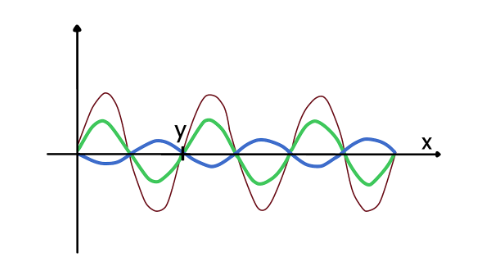
Nodes are points on the resultant waveform where the amplitude consistently equals zero, while antinodes occur at points halfway between the nodes, where the waveform varies from twice the amplitude of the constituent waves in both directions. The amplitude varies to a lesser degree between the nodes and antinodes, depending on the position.
The occurrence of this effect is limited to waveforms with the same amplitude and frequency. If the amplitudes differ, the resulting waveform resembles a standing wave that does not have any nodes and appears to “move”.
Standing waves usually occur when a waveform reflects back on itself, as in the case of microwaves in a microwave oven being reflected by the metal on the opposite side of the oven from the transmitter, creating nodes and antinodes. To ensure that all the food passes through the antinodes and gets cooked, a turntable is required because nothing cooks at the nodes.

Frequencies
Imagine a string that is attached at both ends but can move freely in between. When you pluck the string, a wave is generated and travels along the string in both directions, reflecting at the ends of the string. This process repeats, resulting in the creation of a standing wave pattern. The string moves up and down, as depicted in the first row of the diagram on the right. If you consider the top arc as the first half of a waveform, you can observe that when the string vibrates at the fundamental frequency, it is half the length of the wavelength, or ½λ long. Therefore, λ=2L.
If you pinch the string in the middle and then pluck it on one side, a different standing wave pattern will be produced. Plucking the string creates an antinode, while pinching the string generates a node. When you release the string, the standing wave pattern spreads, and the string length becomes equal to the wavelength. This is referred to as the first harmonic.
Successive harmonics are generated as you pinch the string in descending fractions (½, ⅓, ¼, etc.), and the total length of the string becomes equal to an additional ½λ wavelength for each harmonic.
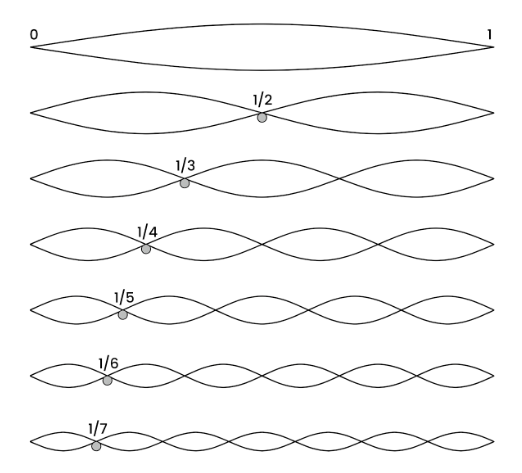
Pipes
Let’s consider a pipe that is closed at one end and open at the other. When waves travel in pipes, they are reflected at the end of the pipe, regardless of whether the end is open or closed. By blowing across the end of the tube, you create a longitudinal wave with the air as the medium. This wave travels down the tube, is reflected, and travels back, creating a standing wave pattern.
The closed end of the pipe serves as a node, similar to pinching a string. Likewise, the open end functions as an antinode, equivalent to plucking a string.
Harmonics can also be present in pipes, which is how musical instruments operate. An open hole in a wind instrument generates an antinode, altering the frequency and pitch of the sound.
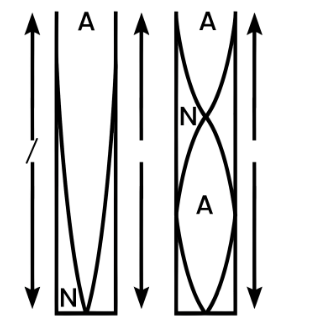
Stationary Waves
Over the past century, stationary or standing waves have gained significant importance in physics. By comprehending them, we have obtained insights not just into sound, but also into many other crucial areas such as AC circuit theory, quantum mechanics, and nanotechnology.
The creation of stationary waves
The necessary conditions for the formation of standing waves are:
1. Two waves moving in opposing directions along the same path and in the same plane.
2. The waves must travel at the same velocity.
3. The waves must have the same frequency.
4. The waves should have a similar amplitude.
Superposition (waves adding/subtracting) When two waves with the same amplitude and frequency are superimposed, a resultant wave is produced. Depending on the phase difference between the waves, the resultant wave may move slowly to the left or right, or disappear altogether. Standing or stationary waves only occur when the phase difference is exactly zero, meaning the two waves are in phase with each other.
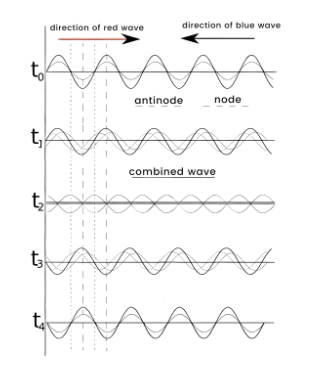
1. Two waves with equal amplitudes approach each other from opposite directions.
2. The phase difference between the two waves decreases, causing the resultant wave to grow in amplitude but not yet in phase with either of the two waves.
3. The two waves are 180 degrees out of phase and cancel each other out, resulting in a black horizontal line.
4. The phase difference between the two waves continues to decrease, causing the resultant wave to grow in amplitude but still out of phase with the two waves.
5. When the phase difference between the two waves reaches zero, the resultant wave reaches its maximum value and is in phase with the two waves.
These in-phase waves create an amplitude that is the sum of the individual amplitudes, forming an antinode. The region between two antinodes where the superposition is zero is called a node.
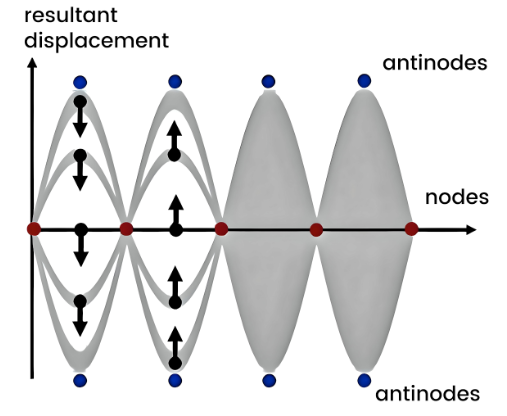
A strobe lamp is used to observe the motion of a horizontal vibrating string, as the antinode areas tend to appear blurry in this demonstration.
Properties of Stationary Waves
The illustration depicts the vertical oscillation of a standing wave over time.
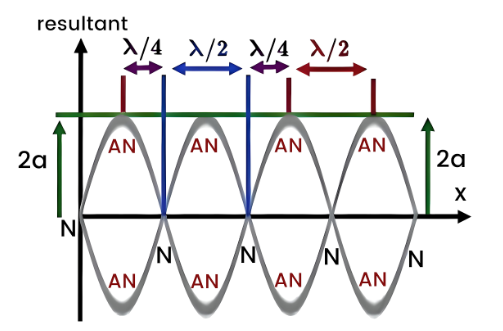
1. The distance between neighboring nodes is equal to half the wavelength (λ/2).
2. Similarly, the distance between adjacent antinodes is also λ/2.
3. Therefore, the distance between neighboring nodes and antinodes is λ/4.
3.The maximum displacement of the wave is 2a (twice the amplitude of a single wave).
4. A standing wave itself does not transmit energy; however, its two constituent waves transfer energy in opposite directions.
Stationary Wave Theory
Two waves, R and L, travel in opposite directions, and their displacements are denoted:
YR =asin(2ft – kx)
YL = asin(2ft + kx)
Respectively,
k = 2
A derivation of the equation for these displacements will be provided under “Derivations – for a deeper understanding” on the Waves menu at a later time.
Upon superposition of the two waves, the displacement yT can be expressed as shown below:
YT = YL + YR
YT = asin(2ft – kx) + asin(2ft + kx)
Using double angle trigonometry, we can obtain the expression ‘Factor Formulae’ :
sin(C – D) + sin(C + D) = 2sin(C)cos(D)
Comparing this equation with the expression for yT, we can deduce that C= 2πft and D= kx.
Substituting these values, we get,
YT = 2asin(2ft)cos(kx)
We can simplify this equation by making,
A = 2acos(kx)
Thus, we get:
YT = Asin(2ft)
The significance of the term A in the standing wave is that it represents the vertical displacement. It is evident from the expression for A that its magnitude varies with the horizontal position x. Let’s examine the magnitude of A at different positions along the standing wave.
At a node, A is zero, while at an antinode, A takes on a value of ± 2a.
A standing wave is a type of wave that is formed by the superposition of two waves with the same frequency, amplitude, and wavelength, traveling in opposite directions. The resulting wave appears to be stationary, with specific points called nodes that remain at rest and others called antinodes that oscillate with maximum amplitude.
A standing wave has several important characteristics, including nodes and antinodes, wavelength, frequency, and harmonics. Nodes are points along the wave where the amplitude is zero, while antinodes are points where the amplitude is maximum. The wavelength of a standing wave is the distance between two adjacent nodes, while the frequency is the number of complete waves passing a point in a given time. Harmonics are multiples of the fundamental frequency that correspond to different standing wave patterns.
Standing waves are produced when two waves of the same frequency and amplitude, traveling in opposite directions, interfere with each other. This can occur when waves are reflected from a fixed boundary, such as a wall or a string fixed at both ends, creating interference patterns that result in standing waves.
Standing waves have many real-life applications, including in musical instruments, telecommunications, and medical imaging. In musical instruments, standing waves are responsible for the formation of harmonics and the unique sound of different instruments. In telecommunications, standing waves are used in antennas to maximize signal strength and minimize interference. In medical imaging, standing waves are used in ultrasound technology to produce detailed images of internal organs.
The wavelength of a standing wave can be calculated using the distance between two adjacent nodes or antinodes. The frequency can be calculated using the formula f = n*v/2L, where f is the frequency, n is the harmonic number, v is the velocity of the wave, and L is the length of the string or resonant cavity.
Resonance occurs when a system is excited at its natural frequency, resulting in the amplification of the wave’s amplitude. Standing waves are a common example of resonance, as they occur when a wave reflects back and forth between two fixed boundaries, reinforcing itself and creating a pattern of standing waves with specific wavelengths and frequencies.
Standing waves and traveling waves differ in several ways. Traveling waves move through space and time, transporting energy from one location to another, while standing waves appear to be stationary, with nodes and antinodes that do not move. Traveling waves can have any frequency and wavelength, while standing waves are constrained by the size and shape of the medium. Additionally, standing waves can only be formed by the interference of two waves with the same frequency and amplitude, while traveling waves can be formed by a single wave or multiple waves with different frequencies and amplitudes.






Still got a question? Leave a comment
Leave a comment